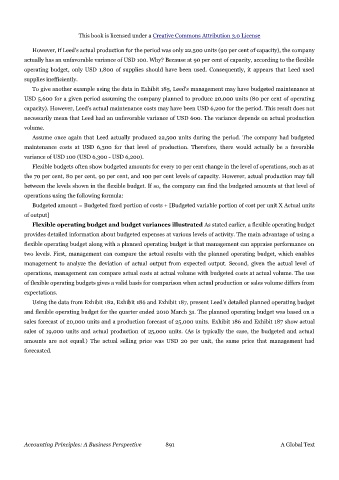Page 890 - Accounting Principles (A Business Perspective)
P. 890
This book is licensed under a Creative Commons Attribution 3.0 License
However, if Leed's actual production for the period was only 22,500 units (90 per cent of capacity), the company
actually has an unfavorable variance of USD 100. Why? Because at 90 per cent of capacity, according to the flexible
operating budget, only USD 1,800 of supplies should have been used. Consequently, it appears that Leed used
supplies inefficiently.
To give another example using the data in Exhibit 185, Leed's management may have budgeted maintenance at
USD 5,600 for a given period assuming the company planned to produce 20,000 units (80 per cent of operating
capacity). However, Leed's actual maintenance costs may have been USD 6,200 for the period. This result does not
necessarily mean that Leed had an unfavorable variance of USD 600. The variance depends on actual production
volume.
Assume once again that Leed actually produced 22,500 units during the period. The company had budgeted
maintenance costs at USD 6,300 for that level of production. Therefore, there would actually be a favorable
variance of USD 100 (USD 6,300 - USD 6,200).
Flexible budgets often show budgeted amounts for every 10 per cent change in the level of operations, such as at
the 70 per cent, 80 per cent, 90 per cent, and 100 per cent levels of capacity. However, actual production may fall
between the levels shown in the flexible budget. If so, the company can find the budgeted amounts at that level of
operations using the following formula:
Budgeted amount = Budgeted fixed portion of costs + [Budgeted variable portion of cost per unit X Actual units
of output]
Flexible operating budget and budget variances illustrated As stated earlier, a flexible operating budget
provides detailed information about budgeted expenses at various levels of activity. The main advantage of using a
flexible operating budget along with a planned operating budget is that management can appraise performance on
two levels. First, management can compare the actual results with the planned operating budget, which enables
management to analyze the deviation of actual output from expected output. Second, given the actual level of
operations, management can compare actual costs at actual volume with budgeted costs at actual volume. The use
of flexible operating budgets gives a valid basis for comparison when actual production or sales volume differs from
expectations.
Using the data from Exhibit 182, Exhibit 186 and Exhibit 187, present Leed's detailed planned operating budget
and flexible operating budget for the quarter ended 2010 March 31. The planned operating budget was based on a
sales forecast of 20,000 units and a production forecast of 25,000 units. Exhibit 186 and Exhibit 187 show actual
sales of 19,000 units and actual production of 25,000 units. (As is typically the case, the budgeted and actual
amounts are not equal.) The actual selling price was USD 20 per unit, the same price that management had
forecasted.
Accounting Principles: A Business Perspective 891 A Global Text

